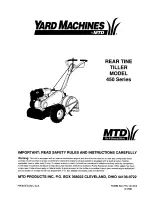
JOHNSON CONTROLS
19
FORM 160.69-N2
ISSUE DATE: 7/31/2015
2
SECTION 2 - INSTALLATION
RIGGING UNIT TO FINAL LOCATION
Rig the unit to its final location on the floor or mount-
ing pad, lift the unit (or shell assembly) by means of an
overhead lift and lower the unit to its mounting posi-
tion. (If optional shipping skids are used, remove them
before lowering the chiller to its mounting position.)
At this point units shipped dismantled
should be assembled under the supervi-
sion of a Johnson Controls representative.
If evaporator is to be field insulated, the insulation
should be applied to the evaporator before the unit is
placed in position while the unit is in the lift position.
Be sure unit is properly supported. (See
LOCATING AND INSTALLING ISOLATOR PADS
(Refer to Figure 2 on page 11 or Figure 3 on page
After the isolator pads have been placed into position
on the floor, lower the chiller onto the pads. When the
unit is in place, remove the rigging equipment and
check that the unit is level. The unit should be level
within 1/4" (6 mm) from one end to the other end and
from front to the rear. If the chiller is not level within
the amount specified, lift it and place shims between
the isolation pad and the chiller tube sheets. (Shims
furnished by the installer.) Lower unit again and re-
check to see that it is level.
CHECKING THE ISOLATION PAD
DEFLECTION
All isolation pads should be checked for the proper de-
flection while checking to see if the unit is level. Each
pad should be deflected approximately 0.10 inchs (2.5
mm) to 0.20 inchs (5 mm). If an isolation pad is under-
deflected, shims should be placed between the unit tube
sheet and the top of the pad to equally deflect all pads.
LEVELING THE UNIT
The longitudinal alignment of the unit should be
checked by placing a level on the top center of the evap-
orator shell. Transverse alignment should be checked
by placing a level on top of the shell end sheets.
INSTALLING OPTIONAL SPRING ISOLATORS
When ordered, spring type isolator assemblies will be
furnished with the unit. The 4 assemblies are identical
and can be placed at any of the 4 corners of the unit.
(Refer to Figure 4 on page 13.)
While the unit is still suspended by the rigging, the iso-
lators should be bolted to the unit by inserting the cap
screws through the holes in the mounting bracket into
the tapped hole in the top of the isolator leveling bolts.
Then the unit can be lowered onto the floor.
The leveling bolts should now be rotated one (1) turn at
a time, in sequence, until the unit end sheets are clear
of the floor by the dimension shown in Fig. 7 or 8 and
the unit is level. Check that the unit is level, both lon-
gitudinally and transversely (see Leveling the Unit). If
the leveling bolts are not long enough to level unit due
to an uneven or sloping floor or foundation, steel shims
(grouted, if necessary) must be added beneath the iso-
lator assemblies as necessary.
After the unit is leveled, wedge and shim under each
corner to solidly support the unit in this position while
piping connections are being made, pipe hangers ad-
justed and connections checked for alignment. Then
the unit is filled with water and checked for leaks. The
leveling bolts should now be finally adjusted until the
wedges and shims can be removed. The unit should
now be in correct level position, clear of the floor or
foundation and without any effect from the weight of
the piping.
PIPING CONNECTIONS
After the unit is leveled (and wedged in place for op-
tional spring isolators) the piping connections may be
made; chilled water, condenser water and refrigerant
relief. The piping should be arranged with offsets for
flexibility, and adequately supported and braced inde-
pendently of the unit to avoid strain on the unit and
vibration transmission. Hangers must allow for align-
ment of pipe. Isolators (by others) in the piping and
hangers are highly desirable, and may be required by
specifications, in order to effectively utilize the vibra-
tion isolation characteristics of the vibration isolation
mounts of the unit.
Check for piping alignment –
Upon completion of








































